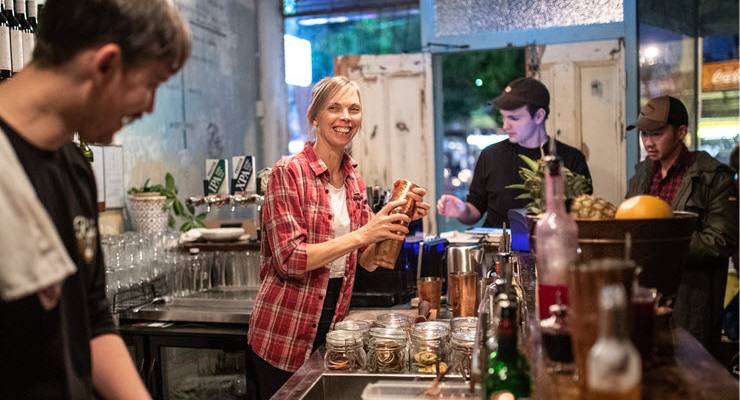
The emerging criticism of the government’s failure to do anything for female employment — and especially women over 35 — in the budget reflects a bigger problem across the political end of the economic debate: we still have a very old-fashioned view of what the Australian economy is.
Yesterday the Grattan Institute, led by Danielle Wood, said the government “seems to think economic stimulus is all about hi-vis vests and hard hats. It’s a narrow and dated view of the world of work … The three sectors with the most targeted support are all bloke-heavy: construction … energy … and manufacturing (A$3 billion).”
A pithy graph summed up where the government’s support had flowed — in contrast to where it was needed.
As we noted yesterday, the government actually has an excellent record of creating jobs for women — but it hasn’t bothered to learn anything from that record in its quest for a “business-led recovery”.
Instead it has reverted to an old view of the economy shared by previous governments, Labor and Coalition, that real economic activity requires someone making something, or digging something up, or moving it somewhere — industries dominated by men.
In reality, about 77% of the economy (based on real gross value added (GVA)) is providing, selling and organising services: education, health and social care (heavily dominated by women), retailing, building and mining services, media, telecoms, finance. The list is long and being added to each week by entrepreneurs.
And that’s where the bulk of recent employment growth has been. Household and business services have dominated employment growth leaving mining, construction and manufacturing in the dust.
Moreover many of those “making things” jobs are highly automated — whether heavily automated manufacturing systems or autonomous mining trucks carting vast amounts of iron ore to remote-controlled trains in the Pilbara. Automation is happening in services, of course, but a vast range are beyond the reach of robots and will be for decades.
But despite less than a quarter of the economy being based on making things, so much of the budget stimulus is skewed towards manufacturing, construction and extractive industries.
Part of that reflects a gender mindset. High-skilled, traditionally male-dominated service sectors like medicine, law and accounting are seen as “professions” rather than services. Female-dominated sectors that also require considerable study and skills — like nursing and education — lack the same social status but do have community respect because we all see the work they put in.
Some service sectors like tourism also attract policymakers because they generate export revenue.
But we’re glibly dismissive of jobs in other service sectors, many dominated by women: hospitality like baristas and wait staff; personal services like hairdressers. Some vital personal services like aged care assistants are also remunerated terribly.
We’re dismissive even though the care of our seniors depend heavily on them. Indeed we’ve become more dependent in recent years as we’ve shifted more of our income from buying things to buying services. We may not hold those jobs in high esteem but we’ve voted with our wallets for them — that’s why employment has boomed in cafes, bars, takeaway and restaurants.
And that’s one of the sectors that’s been hit hardest by the recession. An update of the June quarter National Accounts released yesterday shows the extent of this. GDP fell 7% quarter on quarter in the three months to June. The heaviest part of that fall, however, was in services.
“Spending on services fell 17.6%, reflecting temporary shutdown of businesses and movement restrictions,” the Australian Bureau of Statistics said. That was in contrast to spending on things: “Spending on goods fell 2.8% driven by record falls in operation of vehicles and clothing and footwear, while spending on food recorded the biggest decline since June 1983.”
The reaction from the government, however, has been aimed at helping an economy it thinks should be there, rather than the one that is.









It is not just a dated view of the economy. The disenfranchisement of women and LACK of policies aimed at women is absolutely deliberate.
A known known.
Spending on food is down, we need to chase all farmers away immediately and replace it with banks. It just makes sense, banks have a higher number than farms.
Agree, more about nostalgia and optics for ageing Australians including MPs and media…. Adam Triggs of Inside Story has written similar:
‘Australia’s unhealthy obsession with manufacturing. If the goal is to support workers, women, those hit hardest by Covid-19 and the growth industries of the future, the government should focus on services‘
https://insidestory.org.au/australias-unhealthy-obsession-with-manufacturing/